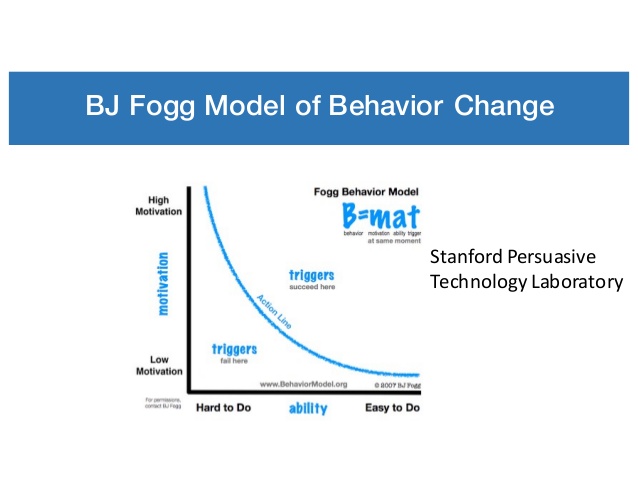What is Behaviour Change?
At its core, behaviour change is about maximising your capabilities whilst minimising your vulnerabilities. Use of digital technologies is one way to achieve this whether through helping people visualise a possible future, finding ways to avoid temptation in a particular scenario or speaking to other people, supporting one another.
Two key models drive our thinking. The first is the behaviour change model from B.J Fogg. This asks us to look at motivation and ability. When motivation is high, it doesn't matter if it is hard to make the change in behaviour, but when motivation is low, it is important to make it easier to trigger the behaviour change.
By way of example, our way of interpreting this, is that when it was made illegal to smoke in bars and restaurants, it was made harder to smoke, especially if it was raining. Or to look at it another way, it was easier to not smoke. So even if motivation was low, the behaviour change of resisting the cigarette could be achieved.
If you want to eat healthy, don't by the junk food in the supermarket. Then it is harder to eat a chocolate bar when sat at home.
Two key models drive our thinking. The first is the behaviour change model from B.J Fogg. This asks us to look at motivation and ability. When motivation is high, it doesn't matter if it is hard to make the change in behaviour, but when motivation is low, it is important to make it easier to trigger the behaviour change.
By way of example, our way of interpreting this, is that when it was made illegal to smoke in bars and restaurants, it was made harder to smoke, especially if it was raining. Or to look at it another way, it was easier to not smoke. So even if motivation was low, the behaviour change of resisting the cigarette could be achieved.
If you want to eat healthy, don't by the junk food in the supermarket. Then it is harder to eat a chocolate bar when sat at home.

Behaviour Change Techniques and Theory
The second theory comes from Susan Michie and colleagues. Through meta analysis of the literature they have come up with the 15 main categories of technique, used to encourage behaviour change. MasterChange intends to use this taxonomy to develop and then categorise all content and to use this categorisation to serve the optimal content to our users at the best possible time.
For example, we might create a content brief around "shaping knowledge" and "Associations", developing engaging content to help you change your behaviours. No single piece of content will work in isolation but by developing a narrative, leveraging this categorisation we aim to develop effective interventions that will help you reach your goals
Theories and Techniques of Behaviour Change Project
Principal Investigator: Susan Michie
Co-Investigators:
Marie Johnston, Alex Rothman, Mike Kelly, Marijn de Bruin
For example, we might create a content brief around "shaping knowledge" and "Associations", developing engaging content to help you change your behaviours. No single piece of content will work in isolation but by developing a narrative, leveraging this categorisation we aim to develop effective interventions that will help you reach your goals
Theories and Techniques of Behaviour Change Project
Principal Investigator: Susan Michie
Co-Investigators:
Marie Johnston, Alex Rothman, Mike Kelly, Marijn de Bruin

